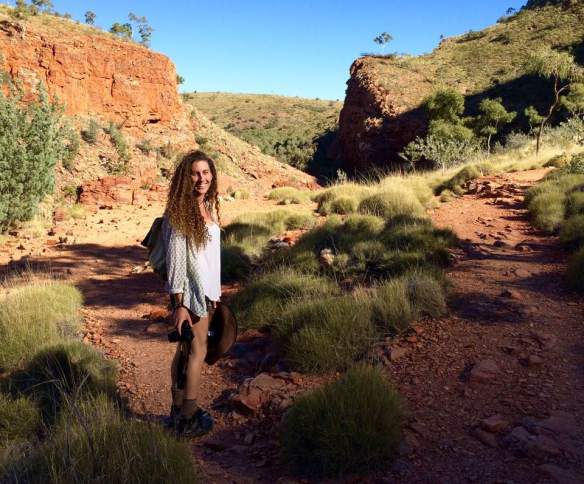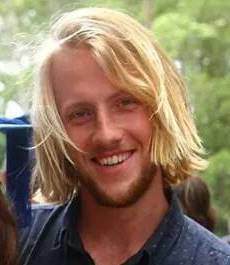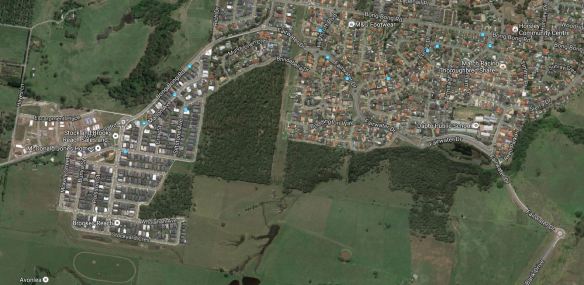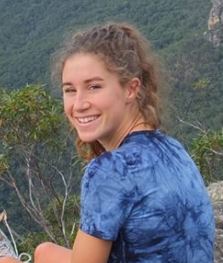The greatest joy in my professional life is interacting with passionate, caring, voraciously intelligent and inspiring research students. I am supervising three such students in 2016 at UOW, who are working on seed bank and recruitment dynamics of threatened coastal and arid vegetation communities.
Below you will find a list of project descriptions and student profiles, as well as available projects for prospective students who wish to work in my lab in 2017.

AVAILABLE PROJECTS – 2017
I have three fully-funded projects available for honours students in 2017:
- Biocontrol of Ageratina species, in collaboration with CSIRO
- Optimising control of woody weeds for biodiversity gain
- Effects of invasive deer on native vegetation and restoration
CURRENT STUDENTS – 2016
Kaisha Edwards (Honours Biological Sciences) – Effects of buffel grass (Cenchrus ciliaris) invasion on native seed viability and dispersal dynamics in arid woodlands of Central Australia (co-supervised by Dr Christine Schlesinger at CDU as part of a long-term Hermon Slade collaboration).
Kaisha’s research is on the impacts of the invasive grass Cenchrus ciliaris on seed bank and dispersal dynamics of native perennial shrubs and trees of Central Australian woodlands. It is well known that invaded areas contain fewer native plant species, but the mechanisms driving this decline is poorly understood. Does buffel grass invasion displace native trees and shrubs through competition for limited resources and alteration of fire regimes, or are impacts driven by disrupted soil seed bank and recruitment dynamics?
Kaisha will specifically investigate whether invaded and non-invaded woodlands differ in the density and richness of seeds within the soil, the viability and dormancy of seeds and interactions between seeds and dispersal mutualists. Previous research has shown that invasion reduces the abundance and activity of ants, and Kaisha has hypothesized that this leads to a reduction in the dispersal of seeds to the soil. As a function of reduced rates of seed removal, Kaisha is expecting to also find a reduction in the diversity and density of seeds in soil in invaded woodlands.

Sophie Natale (Honours Environmental Science) – Seed viability, dormancy, germination requirements and seed bank of threatened Pomaderris species of Eastern Australia (focusing on P. adnata and walshii) (principal supervisor of this project is Dr Mark Ooi, in collaboration with Threatened Species Officers at NSW Office of Environment and Heritage).
Sophie will use a series of lab-based germination assays and glasshouse seedling emergence experiments to investigate effects of fire on seed bank densities, seed viability and germination for two threatened Pomaderris species. Curiously, these species typically have rates of pollination and seed set, yet recruitment and population sizes are extremely low. By studying seed banks and germination cues, Sophie is seeking to discover the reason why populations are in decline despite high rates of seed production and supply to the soil. Sophie’s hypothesis is that soil seed banks are healthy and dense, but that the fire disturbances needed to break seed dormancy and enable seedling germination are inadequate or missing from these sites. Sophie will optimize germination cues for these species, which will inform fire management regimes at sites with small, senescent populations.

Shannon Schofield (Honours Environmental Science) – Impacts of vehicles on salt marsh vegetation, seed banks and soil physiochemistry (co-supervised by Kerrylee Rogers) 
Salt marshes are among the most threatened vegetation communities on Earth. These communities are being squeezed by rising sea levels and shorelines bordered by urban dwelling, roads and farmland. The patterns of community change in response to many anthropocentric disturbances are well-documented, but there is as yet only very little information on impacts to seed banks and soil properties.
Along the eastern coastline of Australia, marshes are widely used for recreational amenity, which has resulted in severe vehicle damage in many locations. Many conservation agencies are attempting to restore marshes damaged by vehicles, but it is unknown whether vegetation will establish passively via the seed bank or if managers must actively promote vegetation growth through planting seedlings or sowing seeds. Shannon will document the spatial extent of vehicle disturbance and its impacts on marsh vegetation, soil seed bank and soil physiochemisty. Shannon will use glasshouse seedling emergence experiments to explore the potential for passive regeneration of marsh via the seed bank.

James Lidsey (Honours Biological Sciences) – Pollination dynamics of woody weeds across a gradient of landscape modification (co-supervised by Prof Kris French UOW)
Weeds significantly threaten native vegetation and cause declines in number and abundance of native plant species. Understanding the drivers of invasion is an important first step in identifying areas prone to invasion and the native species
most at risk of decline.
Classically, invasion dynamics are considered in the framework of competition theory and disturbance. However, it is increasingly being recognized that invasion success hinges on an invasive plant’s ability to ‘tap into’ native mutualism networks (such as pollination and mycorrhiza). Indeed, for most alien flowering plants, successful spread upon introduction will almost certainly be underpinned by interactions with pollinators.
James aims to examine the interactions between pollinators (richness, visitation rates) and the woody shrubs Lantana camara across forested, urban and agricultural landscape contexts of the Illawarra and Shoalhaven regions. James will also examine how proximity to L. camara affects pollinator visitation rates and fruit set in native plants. Given that L. camara produces large, nectar-rich, attractive and dense swathes of flowers throughout the year, James predicts that it will be visited frequently by a diverse array of pollinators. he predicts that L. camara will compete strongly with for pollinator services, and competitively reduce visitation rates to neighboring native plants.

STUDENTS – 2015
Elli-Frances Kircher (Honours Biological Sciences) – Impacts of woody weed invasion on native plant-mycorrhizal associations (co-supervised by Prof Kris French UOW)
Over 80% of flowering plants form symbiotic associations with fungi in the soil, known as mycorrhiza. Mycorrhizal networks enable plants to increase rates of nutrient and water update, and protection against disease and abiotic stress. It is well-known that invasive plants form strong connections with native mycorrhiza upon introduction to a novel location, and that these mycorrhiza enhance an invasive species’ competitive performance against native plants. Classically it is assumed that invasive plants displace natives by directly competition for limited resources, such as soil nutrients and light, or allelopathy. However, a poorly-considered impact mechanism could be disruption to the mycorrhizal network that the native plant communities relies upon for persistence and and sustenance.
Elli’s project will consist of a series of field surveys and glasshouse experiments to determine the effects of Lantana camara invasion on native plant-mycorrhizal interactions. Elli will explore these impacts at a landscape scale between multiple topographical and soil environments.

Gemma Hopkins (Honours Environmental Science) – Effects of anthropogenic landscapes and habitat fragmentation of microbat acivity in remnant woodlands (co-supervised by Prof Kris French UOW and Dr Brad Law, in collaboration with NSW OEH)
Gemma’s research is proudly supported by a student research scholarship through Biosis Pty Ltd)
Fragmentation and land use change threaten native ecosystems – there is probably no single threatening process in ecology that has received as much research attention over the past several decades. However, there is still very little knowledge of the relative importance of patch (e.g. fragment size and shape) and matrix (e.g. land use type, connectivity between adjacent patches) effects on native biota.
Gemma will use anabat technology to sample bat assemblages in remnant woodland patches on the Illawarra coastal plain across a gradient of matrix development. Gemma’s aim is to identify whether certain changes in the surrounding matrix (e.g. replacement of farmland with urban dwellings) affect the diversity and activity of bats within the remnant woodlands.
Are you interested in reading more about this project? We are currently preparing it for submission to a relevant journal, but in the meantime you can get a taste of Gemma’s findings by reading the thesis.

Milo (Liam) Kelly (Honours Environmental Science) – Patterns of invasion of coastal dunes by sea spurge (Euphorbia paralias) (co-supervised by Prof Kris French and Dr Peter Turner at NSW OEH)
An important first step in designing monitoring and containment strategies for emergent weed threats is to document patterns of spread and determine spatial context of invasion risk. Sea spurge is rapidly spreading northwards along the coast of NSW. Populations are so far very rare in the Sydney region, and there is an opportunity to rapidly contain this species and locally eradicate break-outs as they are discovered.
The aim of Milo’s project is to first document the location of sea spurge populations along the southern and central coastlines of NSW, from the state boundary with Victoria to Forster. Milo will use a set of generalized linear modeling procedures to model likelihood of invasion against characteristics of the invaded beach, such as its length, orientation, and wave energy. Ultimately we aim to construct a model that will enable land managers in areas where the weed is not currently present to predict the beaches with the highest risk of invasion in the future. These beaches can be preferentially targeted for monitoring and rapid eradication of new sea spurge populations.

Are you interested in reading more about this project? We are currently preparing it for submission to a relevant journal, but in the meantime you can get a taste of Milo’s findings by reading the thesis.
Eilysh Thompson (Honours Environmental Science) – Reconnecting mycorrhizal networks to facilitate ecological restoration (co-supervised by Prof Kris French UOW)
Winner Allan Sefton Memorial Prize for first in Bachelor of Environmental Sciences (UOW 2015)
Restoration typically involves weed management followed by either passive regeneration of resident native plants or planting seedlings grown in nurseries from locally-sourced seeds. However, the reestablishment of vegetation may be hampered if restoration does not reconnect mutualism networks (e.g. pollination, mycorrhiza) that the native plants rely upon for growth and reproduction.
The aim of Eilysh’s project is to document native plant-mycorrhizal associations at reconstructed (i.e. ‘restored’) and remnant native coastal dunes, to see whether reconstruction of dunes can indeed successfully reconnect plants with their mycorrhizal mutualists in the field. Eilysh will use a series of field and lab-based seedling growth experiments to see if inoculating seedlings grown in nurseries with soil from remnant dunes increases their connection to mycorrhiza and enhances their growth and survival when planted into reconstructed dunes.
STUDENTS 2014
Bess Murphy (Honours Environmental Science). Seed bank dynamics of coastal vegetation (co-supervised by Associate Prof Todd Minchinton & Dr Nathan Knott, UOW).
Winner Allan Sefton Memorial Prize for first in Bachelor of Environmental Sciences (UOW 2014)
Bess is exploring the spatial and temporal dynamics of soil seed banks across coastal vegetation communities. Bess’ project is investigating some fundamental questions about seed bank diversity, seed storage and contribution of germinants to standing vegetation. We are particularly interested in the microsite and community-scale drivers of seed bank diversity and the connectivity of the seed bank across multiple coastal landscapes.


RESEARCH STUDENT INTERNSHIPS
Geoff Clarke – Impacts of urbanisation on salt marsh molluscs
Molluscs are amongst the most important and diverse faunal groups inhabiting coastal salt marshes, itself an endangered plant community. Salt marsh molluscs are responsible for much of the ecosystem’s nutrient cycling and so changes to these  communities have broad consequences for the function of the ecosystem in general. Many snail species, such as Cassidula and Ophicardelus spp. are endemic to salt marsh and are thus potentially more vulnerable to anthropogenic landscape modification than other coastal molluscan taxa.
communities have broad consequences for the function of the ecosystem in general. Many snail species, such as Cassidula and Ophicardelus spp. are endemic to salt marsh and are thus potentially more vulnerable to anthropogenic landscape modification than other coastal molluscan taxa.
The aim of Geoff’s project is to investigate how urbanisation of landward fringes of endangered salt marsh communities modifies the assemblage of resident molluscs. Geoff is focussing on changes to molluscan diversity, abundance and community composition (to the best of our knowledge, the first in Australia to explicitly study such effects).
Miles Moody – Effects of alien plant invasion on native plant-mycorrhizal interactions: implications for restoration of invaded coastal communities. Cosupervised by Kris French, UOW.
Efforts to restore native plant communities following the removal of an invasive plant are frequently met with little success. In coastal dunes invaded by bitou bush, restoration is inhibited by high rates of mortality of native seedlings introduced to sites by bush regenerators. The cause of this mortality is unknown. Is it due to the harsh abiotic conditions (e.g. extreme temperatures, wind shear, salt spray, poor nutrient and water availability) experienced by seedlings in the gaps that were once occupied by bitou? Perhaps it’s due to high rates of herbivory by feral rabbits.
This project is testing a novel mechanisms of seedling mortality: bitou invasion reduces the availability of soil fungi, which in turn limits the establishment success of native seedlings following removal of bitou from the dune. This hypothesis is based on the basic ecologically knowledge that mycorrhizal associations are often required for
plant growth in nutrient-poor and abiotically ‘harsh’ sites (such as the dune).
We are testing this idea using a mesocosm experiment: a suite of native plants used commonly in dune revegetation after bitou removal were planted in marine-derived sand inoculated with soil from dune either dominated by bitou or native vegetation (as well as a control with no inoculate).
So far we have found no evidence that bitou modifies rates of infection of native plant roots by their mycorrhizal symbionts. For example, inoculation with soil increased the abundance of mycorrhizae within roots of poa by about 45% (see Figure 1) over three months, but this effect was not dependent upon the origin of the soil. Indeed, all plants grown in mesocosms inoculated with bitou soil are growing beautifully and are as fecund as those grown in soil obtained from native dune.
So what, then, is responsible for seedling mortality in the dune in areas once invaded by bitou?
Kye Adams – Microsite drivers of macrophytic algal diversity across intertidal rocky shores.
Kye, a marine science student at UOW, is investigating the microsite drivers of algal diversity on rocky shores. Across the globe, the between-shore (e.g. wave exposure, substrate type) and landscape-scale (e.g. currents, latitude) drivers of algal diversity are well-known. However, at any given site, it is unknown what maintains the diversity of the algal community. Research by Underwood, Keough and the like have shown that top-down biotic effects (e.g. grazing) are important, but the role of abiotic attributes of rockpools (e.g. pool size, substrate rugosity, depth) or the location of such pools on the shore (e.g. elevation) remains unexplored.
The study is being done along the picturesque Illawarra coastline! Kye is measuring algal cover and morphospecies richness, as well as the relative abundance of different algal growth forms in intertidal rockpools. We are interested in whether effects of microsite attributes on algal communities vary across functional groups. By answering this question we are hoping to get a better understanding of how algal communities are structured across the shore. Why are some forms (e.g. corallines) more prevalent in some contexts than others, such as thallose algae. What drives this partitioning of the community in terms of growth form? It’s a question that’s had the attention of terrestrial plant ecologists since the 1920s, but has not been tested very often in marine systems.

Lots of interesting stuff going on around you at the moment! nice work 🙂